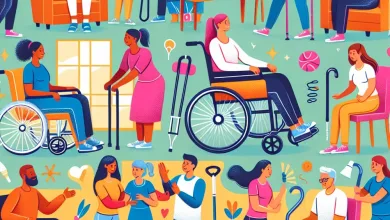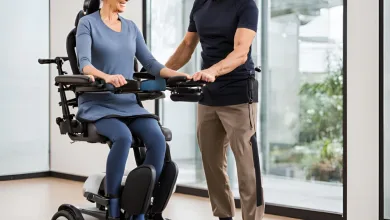How to Build a Support System For Wheelchair Users

Table of Contents
Empowering Yourself Through Connection and Community
Building a support system when you’re a wheelchair user is essential for enhancing your quality of life and achieving your goals. Whether it’s physical assistance, emotional support, or social interaction, a robust support network can help you navigate the unique challenges of using a wheelchair. This guide will provide practical steps and strategies to help you create a comprehensive and inclusive support system.
Understanding the Importance of a Support System
Before diving into the practical steps of building a support system, it’s essential to recognize why it matters. As a wheelchair user, having a solid network of support can:
- Boost your confidence and self-esteem
- Provide practical assistance when needed
- Offer emotional support during challenging times
- Encourage personal growth and independence
- Help you navigate complex systems and bureaucracies
- Expand your social circle and reduce isolation
Now that we understand the significance let’s explore how you can start building a support system tailored to your needs.
Identifying Your Support Needs
The first step in creating an adequate support network is to assess your specific requirements. Every wheelchair user has unique needs, so take some time to reflect on the areas where you could use additional support. Consider the following aspects:
- Physical assistance
- Emotional support
- Social connection
- Professional development
- Medical care
- Legal Advocacy
- Transportation
- Home adaptations
List your priorities and areas where you need the most support. This will help you focus your efforts as you build your network.
Leveraging Existing Relationships
Often, the foundation of a strong support system already exists in your life. Start by contacting family members, friends, and colleagues who understand and are willing to help. Here are some tips for strengthening these connections:
- Open communication: Be honest about your needs and how they can assist you.
- Educate: Help them understand your specific challenges and how they can best support you.
- Set boundaries: Communicate what you’re comfortable with and what you’d prefer to handle independently.
- Show appreciation: Acknowledge their efforts and express gratitude for their support.
- Give Back: Provide support in ways you can, creating a mutually beneficial relationship.
Connecting with Other Wheelchair Users
One of the most valuable resources in your support network can be other individuals who share similar experiences. Connecting with fellow wheelchair users can provide unique insights, practical tips, and a sense of camaraderie. Here are some ways to build these connections:
- Join support groups for disabilities: Look for local or online groups specifically for wheelchair users or individuals with similar mobility challenges.
- Attend adaptive sports events: Participating in or watching adaptive sports can be a great way to meet others and stay active.
- Engage in online communities for wheelchair users: Social media platforms and forums dedicated to wheelchair users can be excellent sources of information and support.
- Volunteer for disability organizations: Engaging in advocacy can connect you with like-minded individuals and expand your network.
- Participate in accessible community events: Look for inclusive events in your area that cater to people with diverse abilities.
Exploring Professional Services and Resources
While personal connections are crucial, professional services can be vital to your support system. Here are some accessible support services to consider:
- Occupational therapists: They can help you develop strategies for daily living and recommend adaptive equipment.
- Physical therapists: Regular sessions can help maintain and improve your mobility and strength.
- Mental health professionals: Counselors or therapists experienced in working with individuals with disabilities can provide valuable emotional support.
- Vocational rehabilitation specialists can assist with job training, career counselling, and workplace accommodations.
- Case managers: They can help coordinate various services and navigate complex healthcare and social service systems.
- Personal care assistants: Depending on your needs, hiring a professional caregiver can provide essential daily support.
Utilizing Community Resources
Many communities offer resources specifically designed to support individuals with disabilities. Explore these wheelchair accessibility resources in your area:
- Centres for Independent Living: These organizations provide various services, including peer support, skills training, and advocacy assistance.
- Local disability resource centres: Many cities have dedicated centres that offer information, referrals, and support services.
- Accessible transportation services: Look into paratransit options or other specialized transportation services in your community.
- Adaptive recreation programs: Many parks and recreation departments offer inclusive programs for individuals with disabilities.
- Accessible housing resources: Organizations that can help you find or modify housing to meet your needs.
Building an Inclusive Support System
Creating a genuinely effective support network means fostering an environment of inclusivity and understanding. Here are some strategies for building an inclusive support system:
- Educate your support network: Help friends, family, and colleagues understand your challenges and how they can create a more inclusive environment.
- Advocate for accessibility: Work with local businesses and organizations to improve wheelchair accessibility in your community.
- Mentor others: Share your experiences and knowledge with newly injured individuals or those struggling to build their support systems.
- Participate in awareness campaigns: Organize events promoting disability awareness and inclusion.
- Foster diverse connections: Build relationships with people from various backgrounds to create a well-rounded support system.
Leveraging Technology for Support
In today’s digital age, technology can be crucial in building a support system. Here are some ways to use tech to your advantage:
- Social media platforms: Connect with other wheelchair users and disability advocates worldwide.
- Assistive technology apps: Explore apps designed to help with daily tasks, navigation, and communication.
- Telemedicine services: Access healthcare professionals remotely for consultations and follow-ups.
- Online learning platforms: Enhance your skills and knowledge through accessible online courses.
- Virtual support groups: Participate in video chat support sessions from your home.
Navigating Legal and Financial Support
An often overlooked but crucial aspect of your support system is having legal advocates for disabilities and financial resources. Consider these options:
- Disability rights organizations: Connect with groups that can provide legal advice and advocacy support.
- Financial planners: Seek professionals experienced in working with individuals with disabilities to help manage your finances.
- Government assistance programs: Research and apply for relevant disability benefits and support programs.
- Nonprofit organizations: Look for charities that offer grants or assistance for medical equipment and home modifications.
- Disability insurance: Explore options for long-term disability insurance to provide financial security.
Maintaining and Nurturing Your Support System
Building a support system is an ongoing process. Here are some tips for maintaining and strengthening your network over time:
- Regular check-ins: Stay in touch with your support network, even when you don’t need immediate assistance.
- Express gratitude: Acknowledge the efforts of those who support you and show appreciation for their help.
- Be proactive: Don’t wait for crises to reach out; maintain open lines of communication.
- Offer support in return: Look for ways to give back to your community and support others when you can.
- Reassess periodically: As your needs change, reevaluate your support system and make adjustments as necessary.
Overcoming Challenges in Building Support
Creating a robust support system can be challenging. Here are some common challenges you might face and strategies to overcome them:
- Fear of vulnerability: Start small and gradually open up to trusted individuals.
- Limited local resources: Leverage online communities and remote services to expand your options.
- Burnout among supporters: Encourage your support network to practice self-care and set healthy boundaries.
- Changing needs: Be open about how your requirements evolve and work with your network to adapt.
- Social anxiety: Consider therapy or support groups to help build confidence in social situations.
The Role of Self-Advocacy in Your Support System
While building a support network is crucial, developing your skills as a self-advocate is equally essential. Here’s how self-advocacy complements your support system:
- Asserting your needs: Communicate your requirements to service providers and supporters.
- Knowing your rights: Educate yourself about disability laws and regulations to ensure fair treatment.
- Problem-solving: Develop strategies to address challenges independently when possible.
- Setting goals: Take an active role in planning your future and working towards personal objectives.
- Seeking information: Stay informed about new resources, technologies, and support options.
Pros and Cons of Different Support Strategies
Let’s take a look at some of the pros and cons of various support strategies:
Conclusion: Empowering Yourself Through Connection
Building a support system as a wheelchair user is a journey of self-discovery, connection, and empowerment. By leveraging personal relationships, professional services, community resources, and technology, you can create a network that enhances your independence and quality of life. Remember that your support system should be as unique as you are, tailored to your specific needs and goals.
As you continue to grow and evolve, so will your support network. Embrace the process of building and refining your support system, and don’t hesitate to reach out when you need assistance. By fostering solid connections and advocating for yourself, you’re not just building a support system but creating a foundation for a fulfilling and empowered life.
FAQs: How to Build a Support System When You’re a Wheelchair User
What is the importance of building a support system for a wheelchair user?
Building a support system is crucial for wheelchair users as it enhances their quality of life, provides practical assistance and emotional support, and helps them achieve personal goals. It also fosters a sense of community and reduces feelings of isolation.
How can I identify my support needs as a wheelchair user?
To identify your support needs, consider physical assistance, emotional support, social connection, professional development, medical care, legal advocacy, transportation, and home adaptations. Reflect on your priorities and areas where you need the most help.
How can I strengthen my existing relationships to build a support network?
You can strengthen existing relationships by maintaining open communication, educating your loved ones about your challenges, setting boundaries, showing appreciation, and providing support in return.
What are some ways to connect with other wheelchair users?
You can connect with other wheelchair users by joining support groups for disabilities, attending adaptive sports events, engaging in online communities, volunteering for disability organizations, and participating in accessible community events.
What professional services and resources are available for wheelchair users?
Professional services for wheelchair users include occupational therapists, physical therapists, mental health professionals, vocational rehabilitation specialists, case managers, and personal care assistants. These professionals can provide essential support and guidance.
How can I utilize community resources to support my needs as a wheelchair user?
Explore community resources such as Centers for Independent Living, local disability resource centres, accessible transportation services, adaptive recreation programs, and accessible housing resources. These services are designed to support individuals with disabilities.
What strategies can I use to build an inclusive support system?
To build an inclusive support system, educate your network about your challenges, advocate for accessibility, mentor others, participate in awareness campaigns, and foster diverse connections. Inclusivity ensures a well-rounded and supportive environment.
How can technology help in building a support system for wheelchair users?
Technology can assist by enabling connections through social media platforms, providing assistive technology apps for daily tasks, offering telemedicine services for remote healthcare, facilitating online learning, and hosting virtual support groups.
What legal and financial support options are available for wheelchair users?
Legal and financial support options include:
- Connecting with disability rights organizations.
- Seeking financial planners experienced with disabilities.
- Applying for government assistance programs.
- Exploring nonprofit organizations for grants.
- Considering disability insurance.
How can I maintain and nurture my support system over time?
Maintain and nurture your support system by conducting regular check-ins, expressing gratitude, being proactive in communication, offering support in return, and periodically reassessing your needs and network.
What challenges might I face in building a support system, and how can I overcome them?
Common challenges include fear of vulnerability, limited local resources, supporter burnout, changing needs, and social anxiety. Overcome these by starting small, leveraging online resources, encouraging self-care among supporters, adapting to evolving needs, and seeking therapy or support groups.
How does self-advocacy complement a support system for wheelchair users?
Self-advocacy complements a support system by helping you assert your needs, understand your rights, develop problem-solving strategies, set personal goals, and stay informed about new resources and support options. It empowers you to take an active role in your support network.
We’d love to hear from you! In the comments section below, share your thoughts, experiences, and any additional tips you might have. Your insights could be incredibly valuable to others on a similar journey. Let’s keep the conversation going and support each other in building stronger, more inclusive communities.



